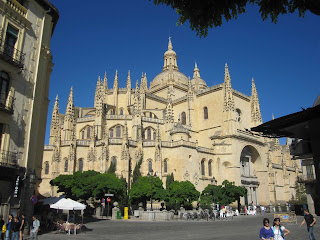A very short train trip to Segovia and we arrived in another ancient, narrow, cobble streeted town. Our hotel bang in the middle of the Mayor Square, pole position for everything.
Neustra Senora de la Asuncion San Frutos Cathedral
(view from our hotel)
The most amazing 15th century Gothic Cathedral is right in our front garden, and the square leads to the Alcazar, a short stroll away.
Built originally in the 11th century over Roman ruins the Alcazar (Palace) was completed in the 15th century and was the home of the Castilian Bourbon Monarchs for several centuries until the seat of Government moved to Madrid. Segovia is an ancient Monastic town with too many monasteries to count.
We discovered also yesterday that Segovia is on one of the old Pilgrim Camino paths to Santiago de Compostela with shell signs showing the way.
At the Alcazar we observed three lofty Stork nests in the trees nearby, some with fledglings in – an interesting sight for us but they can be pests in other areas building their rather large nests in chimneys etc.
High and mighty
An interesting dinner last night at a ‘local’ restaurant. We were the only "strangers" there. They didn't speak much English, but we managed to order somehow. We were determined to try some of the local delicacies and wines. A tasty tomato salad – dressing to die for, a mushroom and whitebait omelet – luscious but a little salty for our taste, “judiones de La Granja”, soft beans in a rich tomato sauce, and a chorizo grill to finish.
Whitebait and mushroom omelet
Bean and tomato dish
We left the Roman Aqueduct to last. It dominates the entrance to the old city and was constructed in the late 1st century BC. It is enormous and is considered a masterpiece of Roman hydraulic engineering being of dry stone construction with no cement or mortar used.
Roman aqueduct
Segovia is known for its slow cooked suckling pig. We have sussed out a good spot to savour it tonight. And what a dinner it was! Classy service and matching food.
An amuse bouche of marinated white anchovies,
stuffed pepper and bacalao.
stuffed pepper and bacalao.
Half (!) a salad of white and grilled green asparagus
with a pistachio vinaigrette
Suckling pig and lamb - a meal fit for a Monarch!













Yes, that's a little pigs foot and the spuds were delicious too. Great meal. Mum said "at least the pig and little lamb gave up their lives for a good cause!"
ReplyDelete